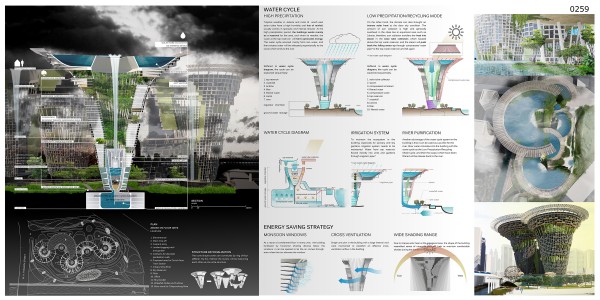Editor’s Choice
2015 Skyscraper Competition
Gigih Nalendra, Nadia Vashti Lasrindy, Reza Arya Pahlevi
Indonesia
Background
Jakarta, the capital of Indonesia, is among the cities that have the highest average annual precipitation (average rainfall) in the world, the average is above 3000mm. Every year floods occur in Jakarta. Widespread flooding occurred in 1996, 2002, 2007, and the latest in 2012. Insufficient reservoir and lack of drainage is one of the causes that can cause flooding, therefore the city needs more of it to keep the excess water, but in reality, the cost of land is really high to make ground reservoir, especially in the city center where it is needed the most.
Concept
From all of those problems, we sought to turn it into an advantage. Our proposal is to use the top of a building as a top reservoir that can cover a large area for rain water catchment, and the fact that the building is tall; the potential energy is also higher due to its high position. Therefore, the energy from the amount of water that falls from the peak into waterfall can generates a massive hydropower to feed the energy needs of the building’s inhabitants.
Water Cycle
Hydropower regarded as the most efficient renewable energy, the existing technology of the hydropower has 90% efficiency, it can respond to quickly changing of the environment needs. Water cycle can be functioned as required by the occupants.
But then what can the building do if there is no rain?. Sun radiation in Indonesia and many countries lies in equator are intense and most of the times are overhead at the clear sky condition, therefore from harvesting the heat from the sun in the solar tube collector, the tube generates steam that can push back the fallen water up to the top reservoir.
The water cycle in the building also benefits the environment, irrigation and sanitary were flowed from top water reservoir to sky gardens, and in certain time the river can be purified, brought by natural pump (steam), river water pushed to top water reservoir and at the ends filtered and taken out to river.
Passive Sustainable Strategies
The building also has several passive sustainable strategies. Monsoon windows let the airflow through cantilevered floor even though rain showers the façade of the building. Single unit plan in the building with a large internal void were maintained to establish effective cross ventilation of airflow in the building. And due to intense solar heat at the equatorial area, the shape of the building resembled series of canopies that will help to maintain comfortable shades during the hottest time of the day.

















